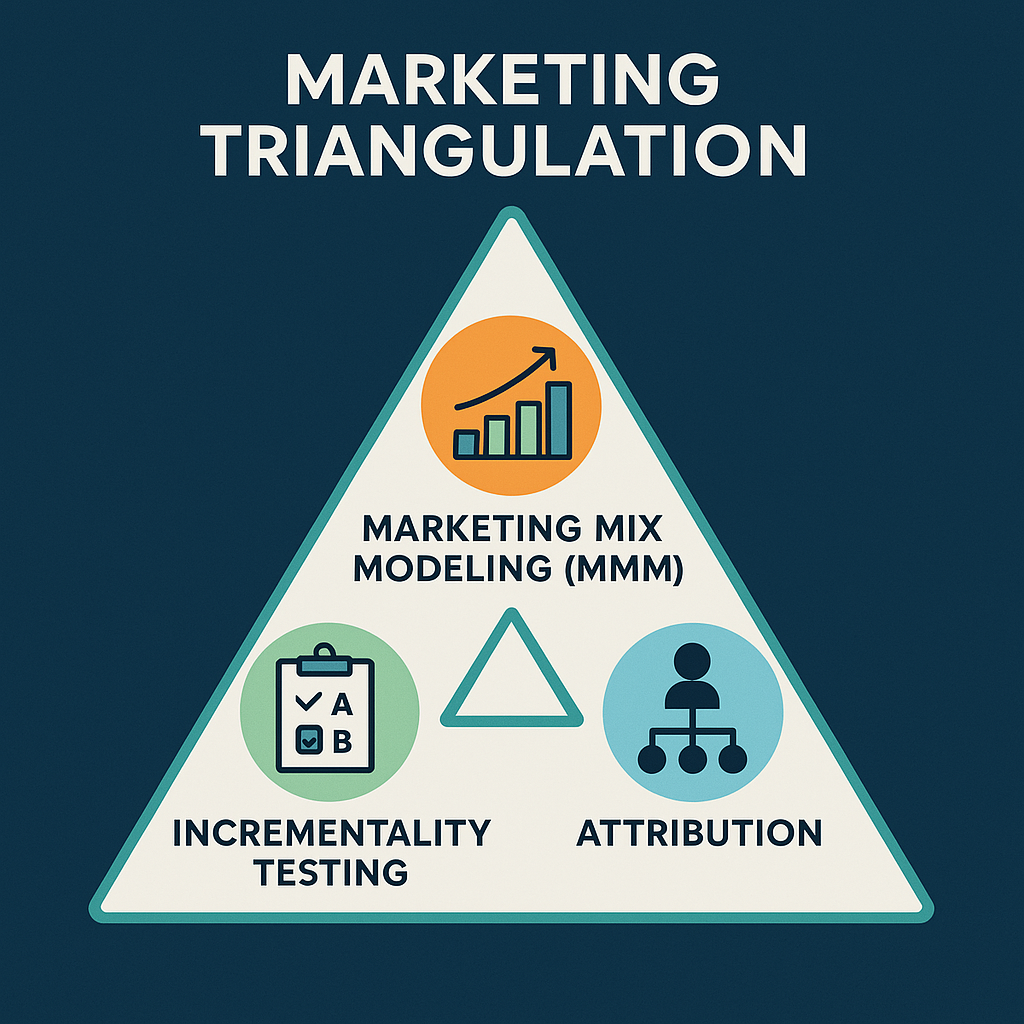In the fast-paced world of digital marketing, businesses constantly seek innovative strategies to improve return on investment (ROI), optimize campaigns, and understand consumer behavior. One of the most robust methodologies emerging as a game-changer for data-driven decision-making is Marketing Triangulation. By effectively integrating Marketing Mix Modeling (MMM), Incrementality Testing, and Attribution, this strategy creates a comprehensive framework that allows corporations to navigate the complex landscape of digital marketing efficiently. While all companies can benefit from these methodologies, larger corporates stand to gain significantly from the unique advantages this triangulation offers.
What is Marketing Triangulation?
At its core, Marketing Triangulation refers to the synergistic use of three powerful analytical approaches to develop a more precise understanding of how marketing efforts drive business outcomes. Here’s a closer look at each component:
1. Marketing Mix Modeling (MMM): This statistical analysis helps companies evaluate the performance of each marketing channel over time, by assessing historical data. MMM assesses the impact of various marketing inputs (like advertising, promotions, and price changes) on sales and helps in budget allocation and forecasting.
2. Incrementality Testing: This approach focuses on identifying the true impact of specific marketing initiatives by comparing the performance of a group exposed to a campaign against a control group that isn’t. This method is instrumental in determining what truly drives conversions, allowing companies to isolate the effects of different marketing strategies.
3. Attribution: Attribution models are crucial for identifying which touchpoints in a customer’s journey contribute to conversions. By evaluating the roles of various interactions—be it social media ads, email campaigns, or search engine marketing—attribution helps clarify the effectiveness of each channel and identify where improvements are needed.
When these three components work together, marketers can harness a more nuanced and holistic understanding of their effectiveness, paving the way for informed decisions and enhanced performance.
Why Bigger Corporates Benefit Most From Marketing Triangulation
While Marketing Triangulation can benefit businesses of all sizes, larger corporations are particularly well-positioned to capitalize on this integrated approach for several reasons:
1. Complex Marketing Landscapes
Bigger companies often navigate diverse and intricate marketing ecosystems, utilizing a multitude of channels and strategies. MMM provides a bird’s-eye view of overall marketing performance while incrementality testing breaks down specific channel efficacy. This allows corporations to make detailed adjustments to maximize the effectiveness of their expansive marketing portfolios.
2. Larger Data Sets for Marketing Triangulation
Large corporations typically have access to more substantial quantities of data, which enhances the accuracy and effectiveness of Marketing Triangulation. MMM and incrementality testing thrive on vast datasets to yield reliable insights. The more data available, the clearer the patterns that emerge, allowing for nuanced analysis and strategic decision-making.
3. Resource Allocation and Budget Management
For larger organizational structures, resource allocation can be a tedious and complicated task. The insights gained through a collaborative approach—where MMM directs resource allocation and incrementality testing assesses performance—enable better-informed budget management. This ensures marketing dollars are spent where they will yield the highest returns.
4. Enhanced Competitive Edge
In industries characterized by intense competition, having a strategic advantage can be the key to staying ahead. By utilizing Marketing Triangulation, corporates can refine their marketing strategies to reach customers more effectively and efficiently, generating more leads and converting them into sales faster than competitors with less sophisticated approaches.
5. Long-term Strategic Planning
Lastly, large firms with substantial marketing investments benefit from a refined ability to plan for the long term. Integrating MMM allows for forecasting based on historical trends, while attribution informs ongoing campaign optimization, providing a dual advantage: immediate responsiveness paired with sustainable growth strategies.
Conclusion
Marketing Triangulation is more than just a buzzword; it represents a powerful strategy that aligns data-driven methodologies to provide deeper insights and superior decision-making capabilities. For larger corporates that operate in complex environments, the combined forces of Marketing Mix Modeling, Incrementality Testing, and Attribution can create a robust system for optimizing their marketing efforts. By embracing this triangular approach, companies can transform the uncertainty of digital marketing into informed, strategic growth, ensuring their campaigns are not only effective but also adaptable to the ever-changing marketplace.
In a landscape where every marketing dollar counts, Marketing Triangulation could very well be the key to unlocking unprecedented success.

